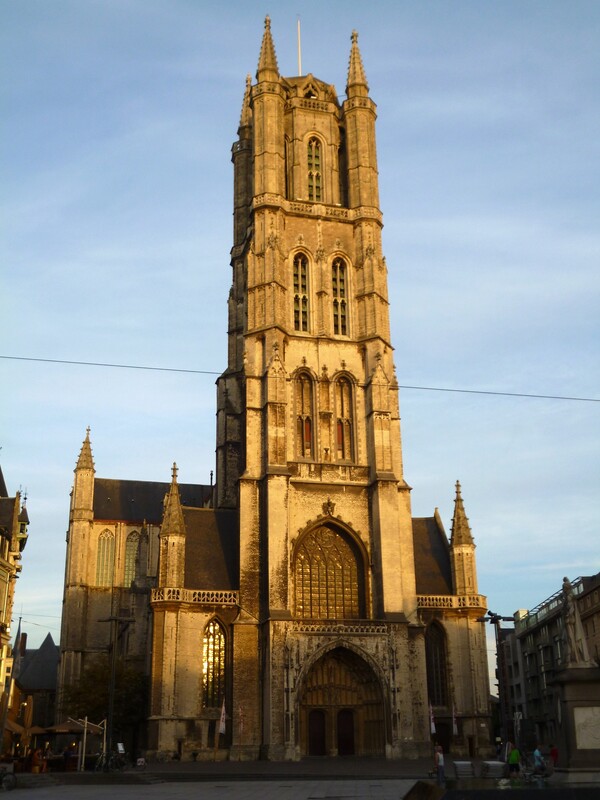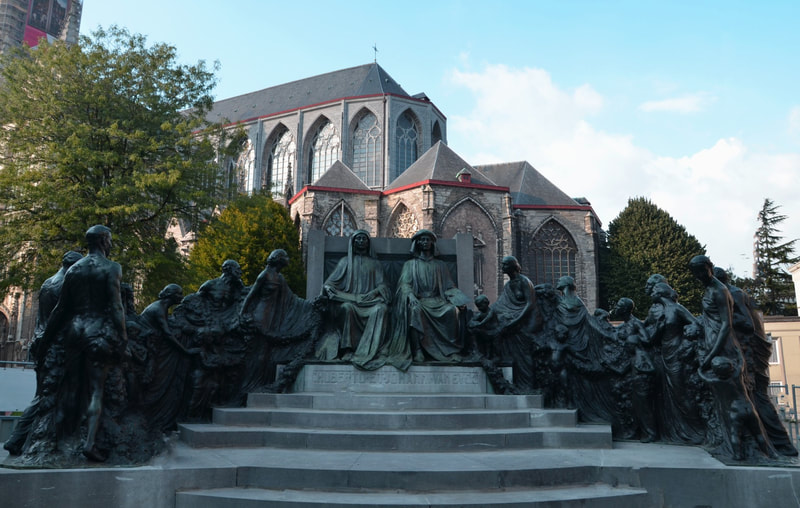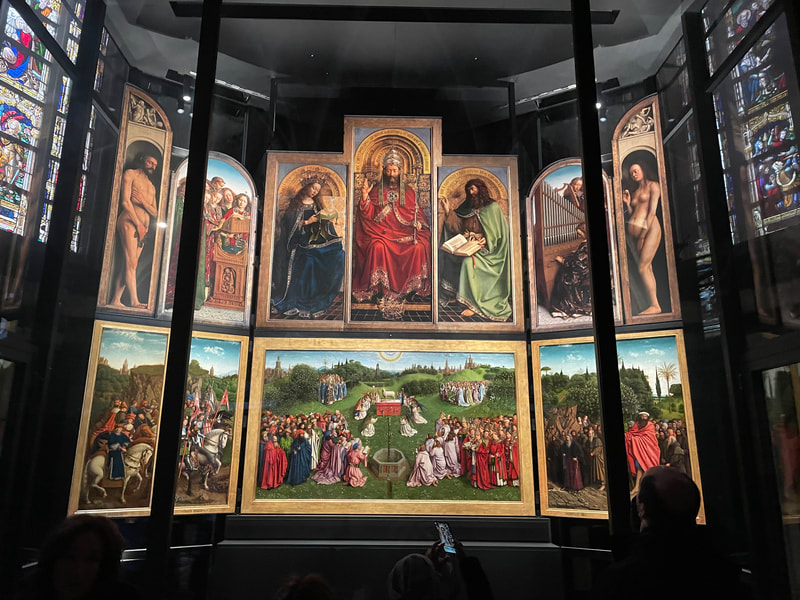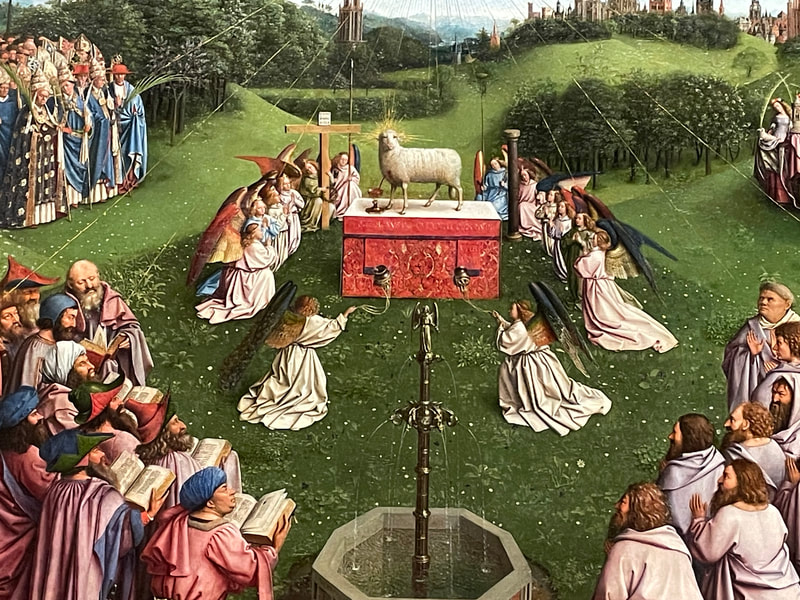Sint-Baafskathedraal
Katedra Świętego Bawona to najstarszy kościół parafialny w Gandawie. Fundamenty tej powstałej z czerwonej cegły i kamienia budowli oparte są na bazie pierwotnej kaplicy św. Jana Chrzciciela, o konstrukcji głównie drewnianej, konsekrowanej przez Transmarusa, biskupa Tournai i Noyon, w 942 roku. Na jej miejscu, w XII wieku, zbudowano na planie krzyża kościół pod tym samym wezwaniem. Ślady tej romańskiej budowli znajdują się w bogato dekorowanej krypcie katedry. Na zewnątrz nie ma już żadnych pozostałości po tej świątyni. Z czasem kościół romański zaczął ustępować miejsca gotyckiej katedrze.
The history of the construction of Saint Bavo's Cathedral
At the beginning of the 14th century, the presbytery was renovated in the Scheldt Gothic style. The crypt was enlarged to a size equal to the size of the presbytery, creating the largest crypt in Belgium. Ambit (bypass, a narrow passage in church architecture created by extending the side aisles and leading them around the presbytery, behind the main altar) and the chapel finials come from the 15th century. Then the western tower of the temple was built (height 82 meters).
In the year 1602, the wooden dome of the tower burned down due to a lightning strike. It was never rebuilt.
The construction of the main nave, transept and eight side chapels began in 1553. The towers and later parts of the chapel were built in the Brabant Gothic style. Not only is there a difference in styles, but also a contrast between the blue Tournai granite used to build the presbytery and the sandstone and brick used to build the naves.
The construction of the main nave, transept and eight side chapels began in 1553. The towers and later parts of the chapel were built in the Brabant Gothic style. Not only is there a difference in styles, but also a contrast between the blue Tournai granite used to build the presbytery and the sandstone and brick used to build the naves.
Treasures of Saint Bavo's Cathedral
W wyniku wystąpienia przeciwko cesarzowi Karolowi V stare opactwo św. Bawona zostało rozwiązane. Opat wraz z mnichami musieli przenieść się do kościoła św. Jana, który otrzymał nowego patrona i stał się kościołem św. Bawona. W roku 1559 ufundowano diecezję Gent (Gandawa), a kościół św. Bawona podniesiono do rangi katedry.
Bogate barokowe wnętrze kościoła jest wynikiem starań jednego z najdłużej rządzących w Gandawie biskupów Antonius'a Triesta. Katedra była plądrowana przez ikonoklastów dwukrotnie, w 1566 i 1578 roku. Od 2006 roku rozpoczęto restaurację kościoła. W XVIII wieku katedra miała karylion z 39 dzwonami. Dzisiaj na wieży pozostały tylko trzy dzwony. Wewnątrz świątyni znajduje się wiele wspaniałych dzieł sztuki światowej sławy.
Bogate barokowe wnętrze kościoła jest wynikiem starań jednego z najdłużej rządzących w Gandawie biskupów Antonius'a Triesta. Katedra była plądrowana przez ikonoklastów dwukrotnie, w 1566 i 1578 roku. Od 2006 roku rozpoczęto restaurację kościoła. W XVIII wieku katedra miała karylion z 39 dzwonami. Dzisiaj na wieży pozostały tylko trzy dzwony. Wewnątrz świątyni znajduje się wiele wspaniałych dzieł sztuki światowej sławy.
Painting Adoration of the Mystical Lamb
this is the greatest treasure that the cathedral hides. This wonderful polyptych is one of the greatest images of medieval painting. This work by Hubert and Jan van Eyck, consisting of 12 paintings-tablets, presents the history of biblical man from the fall in paradise to redemption. The main part shows the adoration of the Lamb of God. The painting was commissioned by Judocus Vijdt, senior councilor of Ghent in 1432. This work is exhibited in the chapel to the left of the entrance.
This world-class polyptych is 3,6 m high and 4,8 m wide. It consists of twelve panels in two rows, four in the center and four on each wing, painted on both sides. Twenty-four distinct but thematically related works show a different view depending on whether the altar is open or closed.
This world-class polyptych is 3,6 m high and 4,8 m wide. It consists of twelve panels in two rows, four in the center and four on each wing, painted on both sides. Twenty-four distinct but thematically related works show a different view depending on whether the altar is open or closed.
This phenomenal work was painted extremely realistically, based on direct observations. For the first time, such realism and mastery in using oil paints were shown. There are no idealized ancient silhouettes or flattening of the image, typical of medieval works. Each character painted by the van Eyck brothers was depicted in great detail. This incredible attention to detail can be seen in the presented buildings, landscape elements, vegetation, fabrics and animals.
Wyjątkowa jest również historia tego dzieła. W 1556 roku uniknęło ono losu innych dzieł sztuki zniszczonych podczas rewolty ikonoklastów. W późniejszych latach obraz ocalał z pożaru. W purytańskim XVIII wieku, z rozkazu cesarza Józefa II obraz, na którym nago występują Adam i Ewa został zastąpiony kopią z ubranymi pierwszymi rodzicami (ta kopia wciąż jest wystawiana w kaplicy Vijdta). Za czasów Napoleona środkowa część dzieła trafiła do Luwru, skąd powróciła dopiero po śmierci cesarza.
Ołtarz zamówiony u Huberta van Eycka po jego śmierci, w 1426 roku, został ukończony przez młodszego z braci Jana van Eycka. W katedrze znajdziemy również obrazy takich mistrzów jak: Peter Paul Rubens, Joos van Wassenhove, czy Hieronymus Duquesnoy Młodszy.
Ołtarz zamówiony u Huberta van Eycka po jego śmierci, w 1426 roku, został ukończony przez młodszego z braci Jana van Eycka. W katedrze znajdziemy również obrazy takich mistrzów jak: Peter Paul Rubens, Joos van Wassenhove, czy Hieronymus Duquesnoy Młodszy.
|
Address:
Sint-Baafsplein, 9000 Gent, Belgie https://www.sintbaafskathedraal.be/ Opening hours:
poniedziałek-sobota: 8.30-17.30 niedziela: 13.00-17.30 |
Ticket price:
Zwiedzanie katedry: za darmo Oglądanie obrazu: 12,50 Euro Godziny otwarcia kaplicy z obrazem :
poniedziałek-sobota:10.00-17.00 niedziela: 13.00-17.00 |



